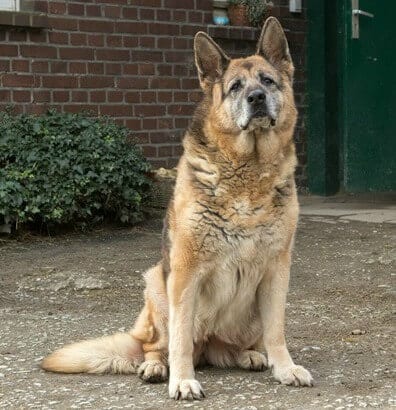Dogs bring an abundance of joy, happiness, companionship, and loyalty. The biggest flaw about dogs is that their lifespan is relatively short compared to ours.
When a dog transfers into senior status, it’s normal for them to slow down and accumulate various health conditions.
As a pet parent, we must face the reality that our beloved friend and family member may be approaching the end of their lifespan.
 No dog parent wants to imagine the inevitable, but when the time comes, it’s a heart-wrenching part of loving a pet.
No dog parent wants to imagine the inevitable, but when the time comes, it’s a heart-wrenching part of loving a pet.
If your dog is enduring pain and suffering due to age, failing health, or severe disease, you need to put your emotions in check and consider what is best for your dog.
Some conditions are manageable with surgery, meds, or alternative holistic regimes. If or when these options are no longer working, you must put your dog’s quality of life first and accept you are going to have to let your best friend go.
Deciding to put your dog down is a tough decision. Determining when you should put your dog down is another hard decision. You want to keep your dog with you for as long as possible, but as a responsible and caring parent, you don’t want to wait too long if your dog is immobile or in pain.
Some dogs become victims of disease, pain, and suffering very quickly. One day your best friend is fine, and the next day they are gone. This scenario catches owners off guard. The decision to let your dog move to a pain-free existence may have a sense of urgency. Many vets will gently ease you towards the obvious decision and the right thing to do.
Other dogs decline gradually over time. Routines change and become the new normal. Regardless you need to be observant and realize when your dog merely exists instead of living.
Dogs know when they are sick, weak, and old. They know when they have become a ghost of their former selves. They know when their journey and time spent with you is coming to an end. They become ready to move on and give signals to help make one of the worst decisions a little easier. Our job as dog parents is to read and acknowledge those signs.
Below are Ten Indicators Your Dog May Be Ready to Cross the Rainbow Bridge
1. No Appetite
Dogs and humans have a lot in common. Eating and the fondness for food is one common trait. We all experience a temporary change or reduction in appetite from time to time due to illness or stress. The same is true for our dogs.
If your dog is showing no interest in food or snacks and consistently not eating, you need to take this behavior seriously. Dogs will lose interest in food as their organs become weaker and normal bodily functions start to fail and shut down. Consult your vet when a loss of appetite is persistent.
2. Rapid Weight Loss
A dog of any age can gain or lose weight due to external factors like diet and exercise.
A temporary loss of appetite and dropping a few pounds is normal. Extreme weight loss in a short period is alarming.
If your dog is losing weight rapidly without reason such as excessive activity, dietary restraint, or a known health condition, you should consult your vet.
3. Incontinence
Young dogs can be incontinent, and some dogs suffer from incontinence their entire lives. Obese dogs may have weaker control of their muscles and hence have incontinence.
Temporary incontinence can be caused by stress or a simple bladder infection.
Incontinence is not an absolute indicator that your dog is ready to cross the rainbow bridge. Failing health, combined with the loss of bladder and bowel movements, should be discussed with your veterinarian.
4. Perpetual Fatigue
An older dog with declining health may lose their appetite, and their body may fail to absorb nutrients. This can cause weight loss and will lead to fatigue. Monitor your dog’s activity level. If they have no energy and are not interested in normal activities they use to enjoy, this is a sign.
5. Persistent Pain
If your dog is suffering from a chronic condition, they may have persistent pain. If medication cannot manage the situation or bring pain relief to your dog, you and your vet will need to decide if it’s time to let your friend go.
6. Mood Swings
When dogs are near the end of their lifespan, they may seem moody and become unaffectionate. They may be indifferent to settings, activities, and affection they once loved. They may be wary of situations they have always been comfortable in. Dogs experiencing mood swings tend to be sleepy, seem depressed, and behave accordingly.
7. Withdrawal from Immediate Family
Withdrawal is one of the humbling realities of life. Dogs seem to know when their time is up. When they are at this stage, they may withdraw and even distance themselves from their loved ones. If you find your dog secluded and not showing much interest to be around you or family members, this is a severe sign.
8. Breathing Troubles
Dogs tend to have distinct breathing habits. Some dogs have shallow breathing. Some dogs breathe very heavy. If you notice your dog’s breathing pattern change, consult your vet immediately. Dogs nearing the end of their life will inhale and exhale with long pauses in between. Labored breathing is a concern, although not always implying the end of life.
9. Coordination Problems
Elderly dogs tend to have coordination problems. They also suffer from cognitive dysfunction which makes them unsteady, clumsy, dazed, dizzy, or confused. Many old dogs prefer to remain motionless in one place, and some may even choose a completely sedentary lifestyle to cope with their loss of coordination. Disorientation and failing limb control could be due to musculoskeletal disorders and should be diagnosed by a veterinarian.
10. Inability to Stand
When a dog is at the end of their life, they may be unable to stand at all. Extreme weakness, deteriorated muscles, and poor absorption of nutrients tend to make them practically stagnated where they are. There is little to no quality life for your dog at this point.
Deciding to let your best friend go is emotional and painful even when it’s obvious it’s the right thing to do.
Your dog may ready to transition to the Rainbow Bridge, and even if your heart and soul know it’s time, it won’t lessen the pain of losing your best friend.



























